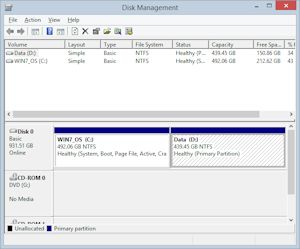
 |
Windows Guide |
Disk Management is a graphical based Disk Management system which is available from the Computer Management console or pressing Windows+X and load Disk Management or pressing Windows+R and entering diskmgmt.msc. Here is an example screen:

A Hard disk can be split into partitions. A disk must have a least one partition called the Primary partition, the can be the System Disk (Windows is installed on this), a Boot Disk (system files installed at root), a Logical Partition such as a Data volume and other type of partitions such as Linux Ext2 partitions. The partition must be formatted with a File System which is an organisation method supplied by the Operating System to store files and Folders. Windows supports FAT32 and NTFS partitions (it also supports older FAT methods).It is not possible to delete or format the System disk while Windows is loaded, you must boot off the Windows CD and use the drive setup section to delete or format new partitions.
In disk management you can select an unused area of the disk and create new partitions and format them, you can also assign Drive Letters to each new partitions, starting from C: and onwards. Windows supports Basic disks, Dynamic disks and GPT disks. Dynamic disks can be Mirrored or Striped using RAID technology. Basic disks can be converted to Dynamic without data loss but cannot be converted back. The type is shown on the left column of the disk. A GPT (GUID Partition Table) disc is used when multiple partitions (128 max) are required, which a MBR (Master boot record) type disk cannot support.
A disk's status can be Healthy or Online (normal), Foreign (See Help and Support on Disk Management on fixing these types), Not Initialised (which means a Disk Signature has not been written to the disk for XP to see the disk, selecting Initialise Disk will write the signature), or Unreadable (when the disk has not spun up or the file system is corrupted, clicking Rescan Disk may fix this).
Options - Display options for Disk Cleanup utility
Exit - Exits Disk Management
Refresh - Refreshes the disk display if disks are updated
Rescan Disks - Rescan disks and update disk status
Create VHD - Create a Vitual Hard Drive, upto 2 TB in size.
Attach VHD - Attach an existing VHD file.
All Tasks - More tasks such as:-
Open/Explore - Open an Explorer window to view disk contents
Mark Partition as Active - Change the current partition as active boot partition
Change Drive letter and Paths - To change drive letter of a disk or assign a
letter to a folder or path
Format - Clears drive contents and prepares volume for files and folders
Extend volume - Expand the size of an existing volume into any free space.
Shrink volume - Reduce the size of an existing volume into a smaller size.
Add
Mirror - Created a mirrored disk or volme for fault tolerance
Delete volume - Remove and erase an existing volume
Eject - Eject a CD or DVD disk from a CD/DVD drive.
Properties - Display size, and space used as well as label and file system information
New spanned volume - Create a volume that spans multiple disks (RAID)
New stripped volume - Create a volume that spans multiple disks (RAID 0)
New mirrored volume - Create a copy of a volume to another disk (RAID 1)
New RAID-5 volume - Create a stripped volume across multiple disks with parity for fault tolerance (RAID-5)
Convert to Dynamic disk - Change a basic disk to a dynamic disk to allow above volume types.
Convert to GPT disk - Change a disk to a GUID Partition table disk.
Offline - Take a disk offline for maintenance.
Detach VHD - Remove a Virtual hard drive file from system.
Top, Disk List - List all disk drives on PC incl removable drives
Top, Volume List - List all volumes or partitions on the current disk
Top, Graphical View - List disks or partitions like a graph
Bottom, Disk List - List all disk drives on PC incl removable drives
Bottom, Volume List - List all volumes or partitions on the current disk
Bottom, Graphical View - List disks or partitions like a graph
Bottom, Hidden -
Hide volumes details.
Settings - Change colour scheme appearance and scaling of volumes
Drive Paths - List all drive paths for disks
Customise - Change console features such as menus, toolbars etc
Command line tools
The disk management can also be performed from the command line with these tools:
CHKDSK - Check disk for errors.
CONVERT - Convert a volume to a NTFS volume.
DEFRAG - Defragment or analyze a volume.
DISKCOPY - Copy a disk to another disk e.g. floppy disks.
DISKPART - Disk partition tool to view, create, delete, nerge, extend, expand, repair, scan and shrink disks.
DISKPERF - Enable disk performance counters.
DISKRAID - Load DiskRAID tool.
DISKCOMP - Compare two disk contents e.g. floppy disks.
DISM - Manages disk images such as WIM or VHD images.
FORMAT - Format a volume for given filesystem and provide a label.
MOUNTVOL - Create, delete or lists a volume mount point.
RECOVER - Recover readable information from a defective disk.